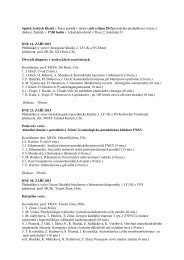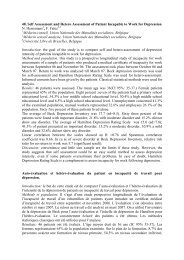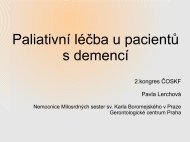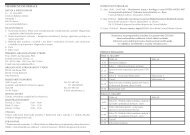ABSTRACTS â ORAL PRESENTATIONS - AMCA, spol. s r.o.
ABSTRACTS â ORAL PRESENTATIONS - AMCA, spol. s r.o.
ABSTRACTS â ORAL PRESENTATIONS - AMCA, spol. s r.o.
You also want an ePaper? Increase the reach of your titles
YUMPU automatically turns print PDFs into web optimized ePapers that Google loves.
P41. WHY CAN WE SEE DIFFERENT RADIOSENSITIVITY OF LYMPHOCYTE SUBSETS?<br />
Lenka Zárybnická 1 , Zuzana Šinkorová 1 , Zuzana Kročová 2 , Jiřina Vávrová 1<br />
1<br />
Department of Radiobiology, Faculty of Military Health Sciences, University of Defence,<br />
Hradec Králové, Czech Republic; zarybnicka@pmfhk.cz<br />
2<br />
Institute of Mollecular Pathology, Faculty of Military Health Sciences, University of<br />
Defence, Hradec Králové, Czech Republic<br />
Lymphocytes exposed to gamma-ray irradiation experience a degradation of their<br />
macromolecules, especially DNA. Cells unsuccessful in DNA repairing process<br />
induce apoptosis. Analysis of apoptotic peripheral blood mononuclear cells (PBMC)<br />
by phosphatidyl serine detection (Annexin-V antibody) after in vitro irradiation is<br />
dose dependent thus PMBC can be used as in vitro sensitive biodosimetric markers<br />
(Šinkorová et al. 2011). Nevertheless, it is not possible to detect the apoptotic fraction<br />
by Annexin-V antibody after in vivo irradiation (our unpublished results) due to the early<br />
in vivo elimination of apoptotic cells from peripheral blood by active scavenging system<br />
(Bogdandi et al. 2010), thus only the not influenced cells or repaired cells can be in vivo<br />
studied. Many of studies confirmed different radiosenzitivity of individual lymphocyte<br />
subsets where especially B lymphocytes are the most radiosensitive (Girinsky et al.<br />
1991).<br />
In this work we studied the radiosenzitivity of peripheral blood T-lymphocytes,<br />
B-lymphocytes and natural killers (NK cells). We were looking for changes between<br />
individual lymphocyte subsets after in vivo irradiation ( 60 Co, gamma source) focusing<br />
on the very early phase of apoptosis when a decrease of mitochondrial membrane<br />
potential ( D<br />
ψ) occurs and furthermore on the period which precede the apoptosis, the<br />
cell repair process. At the site where DNA is damaged the DNA double-strand breaks<br />
(DSB) are produced and DNA damage repair factors are accumulated on chromatin.<br />
One of the key processes activated within minutes after the DSB induction is the<br />
phosphorylation of histone H2AX at serine 139 (γ-H2AX). γ-H2AX expression assessment<br />
has been successfully exploited as in vivo biodosimetric marker (Rothkamm and Horn<br />
2009). Mitochondrial membrane potential changes occuring within very early phases of<br />
apoptosis can be analyzed by D<br />
ψ-sensitive probe (JC1) which has been successfully used<br />
within many apoptotic studies. We established new protocols combined intracellular<br />
detection of γ-H2AX, respective D<br />
ψ changes, with extracellular immunophenotyping<br />
surface markers specific for rat or porcine NK cells (CD8, CD161), T-lymphocytes (CD3,<br />
CD4, CD8) and B-lymphocytes (CD45RA) which were analyzed by flow cytometry<br />
(CyAn ADP, Beckman Coulter). Using the animal experimental models (Wistar rats and<br />
large white pigs) which were influenced by in vivo irradiation the changes of γ-H2AX<br />
expression, respective D<br />
ψ decrease, within lymphocyte subsets were analyzed. Studies<br />
were approved by the Ethical Committee of the Faculty of Military Health Sciences in<br />
Hradec Kralove and by the Ethical Committee of the Ministry of Defence of the Czech<br />
Republic.<br />
In our previous studies we confirmed that each lymphocyte subset within both animal<br />
models (porcine, rat) exerts its own characteristic in vivo radiosenzitivity. In this study,<br />
136 Analytical Cytometry VII








